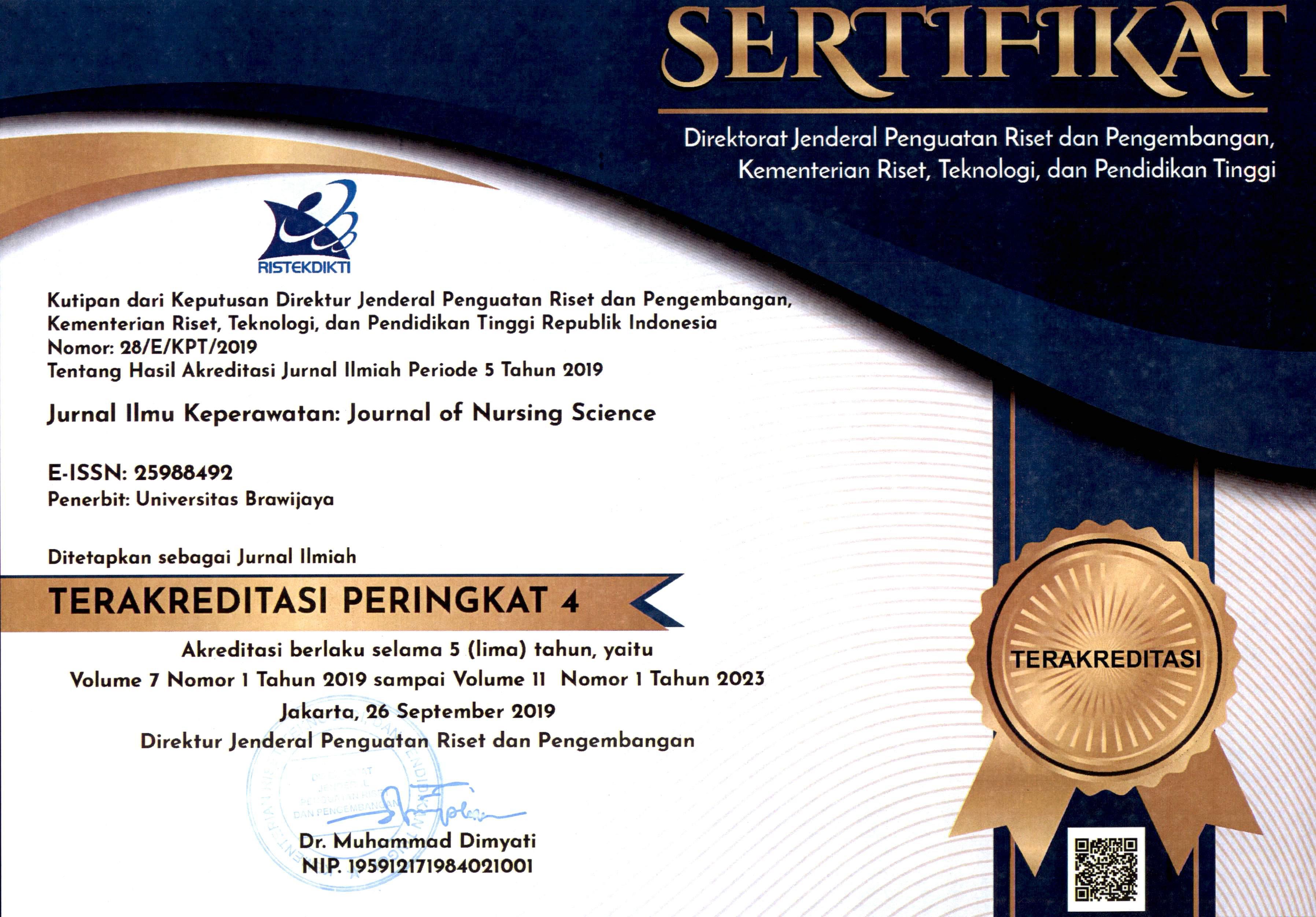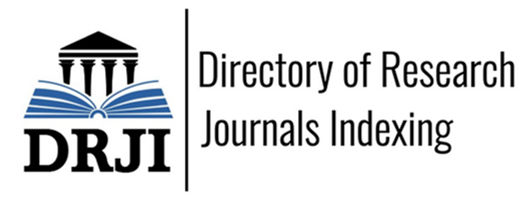GETTING READY FOR EARTHQUAKE DISASTER WITH TABLETOP EXERCISE FOR DISASTER MANAGEMENT
DOI:
https://doi.org/10.21776/ub.jik.2020.008.01.4Keywords:
disaster management, table top exerciseAbstract
Disaster is an event that can destruct the community living. Malang is a city which have an active seismic, that have high potential of earthquake. To reduce the risk or effect of disaster we need tabletop exercise for disaster management as a mitigation activity. The purpose of this study was to knowing the effect of tabletop exercise on staff readiness once deal with earthquake disaster. This study was quasy experimental with purposive
sampling technique. We obtained 24 respondents from administrative staff of medical Faculty Universitas Brawijaya. They were devided into intervention group (n=12) dan control group (n=12). The readiness was measured with knowledge and attitude score pre and post table top exercise. Wilcoxon signed rank test showed that there were significant differences between score pre and post test of knowledge about disaster management in control group (p value= 0.033) and in intervention group (p value=0.005). Dependent T
test showed that there were significant effect on attitude pre and post table top exercise for disaster management simulation (p value =0,001), but no significant effect in control group (p value =0.376). Independent T-test for attitude and mann whitney test showed that there is no difference between intervention and control group in attitude (p value= 0.318) and knowledge (p value =0.680). In conclusion there is significant effect of tabletop exercise to readiness of the staff medical faculty Universitas Brawijaya once deal with
earthquake disaster. But there is no difference in both method of education
References
- Badan Nasional Penanggulangan Bencana (BNPB).
- Pengetahuan Tentang Bencana. (http://
- bnpb.go.id/pengetahuan-bencana/siagabencana#, diakses pada tanggal 14 Januari 2016
- Pukul 14.30 WIB).
- Badan Nasional Penanggulangan Bencana (BNPB).
- Statistik bencana indonesia 2015, http://
- dibi.bnpb.go.id/).
- Cabinet Office and National security and intelligence UK.
- Emergency planning and preparedness: exercises and training. (https://www.gov.uk/guidance/emergency-planning-andpreparedness-exercises-and-training , diakses tanggal 14 Januari 2016 Pukul 13.52 WIB).
- Indrastuti, N. 2009. Modul Ajar Pengintegrasian Pengurangan Resiko Banjir. Jakarta : Pusat Kurikulum Badan Penelitian dan Pengembangan
- Kementerian Pendidikan Nasional.
- World Health Organization (WHO). 2016. Disaster and Emergency. http://www.who.int/surgery/ challenges/esc_disasters_emergencies/en/
- diakses pada tanggal 14 Januari 2016).
- Peraturan Badan Nasional Penanggulangan Bencana Nomor 14 Tahun 2010 Tentang Pembentukan Pos Komando Tanggap Darurat Bencana.
- Pangesti, A.D.H. 2012. Gambaran Tingkat Pengetahuan dan Aplikasi Kesiapan Bencana pada Mahasiswa Fakultas Ilmu Keperawatan Universitas Indonesia. Universitas Indonesia: Jakarta
- Taylor, M. dan Collins, J. 2008. Conducting Effective Emergency Management Tabletops, Drills and Other Exercises. US Department of Education Office of Safe and Drug Free Schools.
- The Community Emergency Response Team . 2013. CERT Tabletop Exercise Combined. www.fema. gov. diakses tanggal 14 Januari 2016
- Undang-Undang Nomor 24 Tahun 2007 Tentang Penanggulangan Bencana.
- Savoia, E., Agboola, F., dan Biddinger, P.D. 2014. A Conceptual Framework to Measure Systems’ Performance during Emergency Preparedness Exercises. International Journal of Environmental Research and Public Health, 11, 9712-9722; doi:10.3390/ijerph110909712
- Bortolaso, C., Oskamp, M., Graham, N., and Brown, D. 2013. OrMis: A tabletop interface for simulationbased training. Education and Training ITS’13, October 3-6, St. Andrew, UK.
- Perry, R.W. 2004. Disaster exercise outcomes for professional emergency personnel and citizen volunteers. Journal Of Contingencies and Crisis Management, 12(2), 64-75.
- Steward, D. and Wan, T.T.H. 2007. The role of simulation and modeling in disaster management. Journal Med Syst, 31, 125-130
Downloads
Published
How to Cite
License
Authors published in this journal agree to the following terms:
1. The copyright of the received article shall be assigned to the journal as the publisher of the journal. The intended copyright includes the right to publish the article in various forms (including reprints). The journal maintains the publishing rights to the published articles.
2. Authors may enter into separate additional contractual agreements for the non-exclusive distribution of the published journal version of the work (for example, posting it to an institutional repository or publishing it in a book), with acknowledgment of their initial publication in this journal.
3. Authors are permitted and encouraged to post their work online (e.g. in an Institutional Repository or on their website) before and during the submission process, as this can result in a productive exchange, as well as earlier and larger citations of the published work.
4. Articles and all related material published are distributed under Creative Commons Attribution-NonCommercial 4.0 International License or CC BY-NC 4.0 license.
JNSU is licensed under a Creative Commons Attribution-NonCommercial 4.0 International License or CC BY-NC 4.0 license.
Most read articles by the same author(s)
- Bintari Ratih Kusumaningrum, Indah Winarni, Setyoadi Setyoadi, Kumboyono Kumboyono, Retty Ratnawati, PENGALAMAN PERAWAT UNIT GAWAT DARURAT (UGD) PUSKESMAS DALAM MERAWAT KORBAN KECELAKAAN LALU LINTAS , Journal of Nursing Science Update (JNSU): Vol. 1 No. 2 (2013)
- Ika Setyo Rini, Dini Widya Ayuningtyas, Retty Ratnawati, FAKTOR-FAKTOR YANG BERHUBUNGAN DENGAN PERSEPSI GEJALA NYERI DADA KARDIAKISKEMIK PADA PASIEN INFARK MIOKARD AKUT DI RSUD dr. SAIFUL ANWAR MALANG , Journal of Nursing Science Update (JNSU): Vol. 5 No. 1 (2017)
- Setyoadi Setyoadi, Ika Setyo Rini, Triana Novitasari, HUBUNGAN PENGGUNAAN WAKTU PERILAKU KURANG GERAK (SEDENTARY BEHAVIOUR) DENGAN OBESITAS PADA ANAK USIA 9-11 TAHUN DI SD NEGERI BEJI 02 KABUPATEN TULUNGAGUNG , Journal of Nursing Science Update (JNSU): Vol. 3 No. 2 (2015)
- Ikhda Ulya, PENGARUH PEMBERIAN GEL EKSTRAK DAUN MELATI (Jasminum sambac L. Ait) TERHADAP JUMLAH FIBROBLAS KULIT DALAM PENYEMBUHAN LUKA BAKAR DERAJAT II A PADA TIKUS PUTIH (Rattus norvegicus) GALUR WISTAR , Journal of Nursing Science Update (JNSU): Vol. 4 No. 1 (2016)
- Bintari Ratih Kusumaningrum, RENCANA TINDAKAN TERTULIS PASIEN ASMA (WRITTEN ASTHMA ACTION PLANS:WAAPS) SEBAGAI PANDUAN EDUKASI UNTUK MENJARANGKAN KUNJUNGAN ASMA KE UNIT GAWAT DARURAT , Journal of Nursing Science Update (JNSU): Vol. 3 No. 2 (2015)
- Ika Setyo Rini, Niko Dima Kristianingrum, Rizka Widyastikasari, RELATIONSHIP BETWEEN LEVEL OF DISASTER KNOWLEDGE AND ATTITUDE OF LANDSLIDE DISASTER PREPAREDNESS IN VOLUNTEERS "KELURAHAN TANGGUH†IN MALANG CITY , Journal of Nursing Science Update (JNSU): Vol. 7 No. 2 (2019)
- Ikhda Ulya, Retty Ratnawati, Kumboyono Kumboyono, POLICE OFFICER’S EXPECATTIONS AS A FIRST RESPONDER IN ROAD TRAFFIC ACCIDENTS: A QUALITATIVE STUDY , Journal of Nursing Science Update (JNSU): Vol. 7 No. 1 (2019)





























